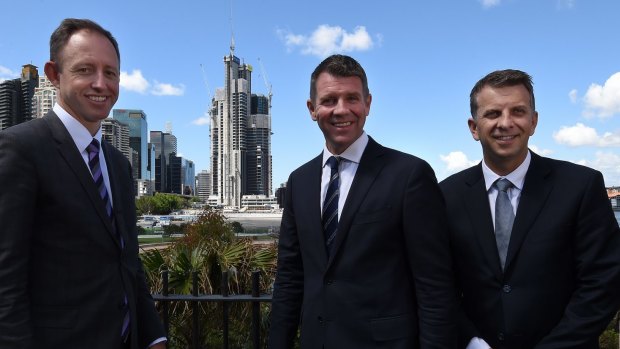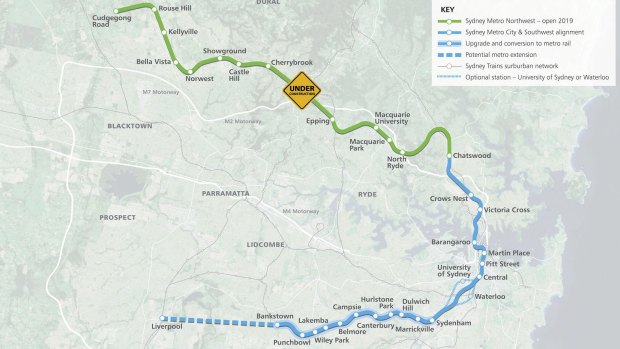By Jacob Saulwick
There is a $20 billion-plus unanswered question at the heart of the biggest public transport project in Sydney, NSW and Australia. And it is highly likely the Baird government will at least pretend over the coming year to let the community have its say in answering the question.
The question, in essence, is where will another rail line run south of Sydney harbour?
Prompting the question is the current $20 billion construction of a metro line from Rouse Hill past Chatswood to the city and beyond. South of the harbour, that line is to connect to the existing Bankstown Line, through stations such as Marrickville, Canterbury, and Lakemba.
But when you think about it, the new train line cannot go in only one direction to Bankstown. Because cross-city rail lines are built so rarely – the last was the eastern suburbs rail line in the 1970s, the one before that the Harbour Bridge – it is imperative they deliver as much overall benefit to the city as possible.

Program director of Sydney Metro Rodd Staples (left) with Premier Mike Baird and Minister for Transport and Infrastructure Andrew Constance moments after making a Sydney Metro announcement at Barangaroo last year. Credit: Kate Geraghty
The sales pitch for the metro line proclaims that it will have capacity for a train every two minutes. There is patently no need for a train to run to Bankstown every two minutes.
Instead, it makes sense for trains to run every two minutes through the busiest stops in the city and then for the line to then fork in two, running trains every four minutes to two separate destinations. (North of the harbour, there are long-term plans for a "fork" to run under Military Road towards the Northern Beaches).
If Bankstown, or possibly Liverpool, is to be the tip of one of the forks south of the harbour, what should be the second?
When the state government announced the cross-harbour metro line across in 2012, it said it expected to link it to two existing lines to the south: the Bankstown and the Illawarra Line to Hurstville.

A map of the new metro line from Sydney's north-west to the south-west via the CBD.
But at the time people who know about these things said it would be costly and difficult to use the Illawarra Line. Freight trains cross these tracks, and there would be conflicts between heavy freight trains and the driverless metro trains
The government appears to have accepted this advice and quietly dropped plans to extend the line to Illawarra. So what about that second fork?
One interesting perspective on this comes from a former head of rail planning at RailCorp, Dick Day, who, among other things, helped make the trains run on time at the Olympics.
According to Day's analysis, the "elephant in the room" in the government's plans remains the need to do something about the growth in rail passengers on the Western Line past Strathfield. On the government's own numbers, those trains will soon be full to bursting.
According to Day, the new metro line could help relieve this congestion, but only if it adds capacity where it is needed: to this western corridor.
He proposes two solutions. One is cheaper, but both would cost billions.
The cheaper option, which Day appears to prefer, is to connect a second branch of the new metro line to the existing Inner West Line to Homebush, in the same way in which the Bankstown Line is being "converted" to metro rail.
This would mean existing stations in the inner west such as Newtown and Petersham would get the benefit of trains every four minutes.
At the same time, however, a new rail tunnel would need to be dug from the existing Homebush area to Central.
This tunnel would be necessary to allow 20 express trains an hour from stations west of Strathfield, such as Parramatta and Blacktown, to run into the City Circle, using the free space created by the removal of the Bankstown and Inner West trains to the metro line.
The advantage of this scheme is that it is cheaper, relatively speaking, to build rail tunnels than to build rail stations. The 15-kilometre tunnels recently dug for the north-west line, for instance, cost about $1.15 billion. But one underground rail station costs half a billion alone.
The other option, Day says, is the more expensive alternative of building another metro rail corridor between Central and Parramatta, complete with its own new stations. On recent lobbying, there is likely to be demand for new stations on such a line at least around Rozelle, Olympic Park, and potentially Canada Bay.
Transport for NSW has already started to update the state's 2012 transport masterplan, with a new document due in 2017.
It is to be hoped that the government involves the community in a genuine discussion of the advantages and disadvantages of the different options, rather than its past practice of making substantive decisions behind closed doors. Those decisions often prove to be wrong.